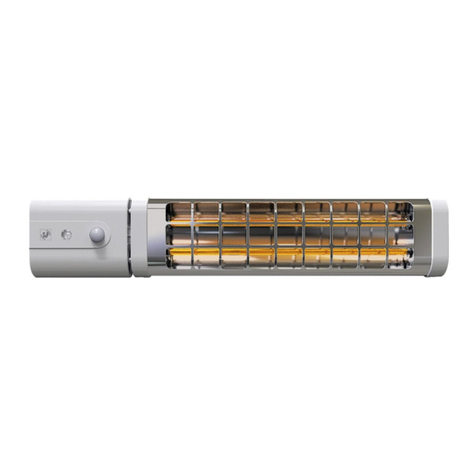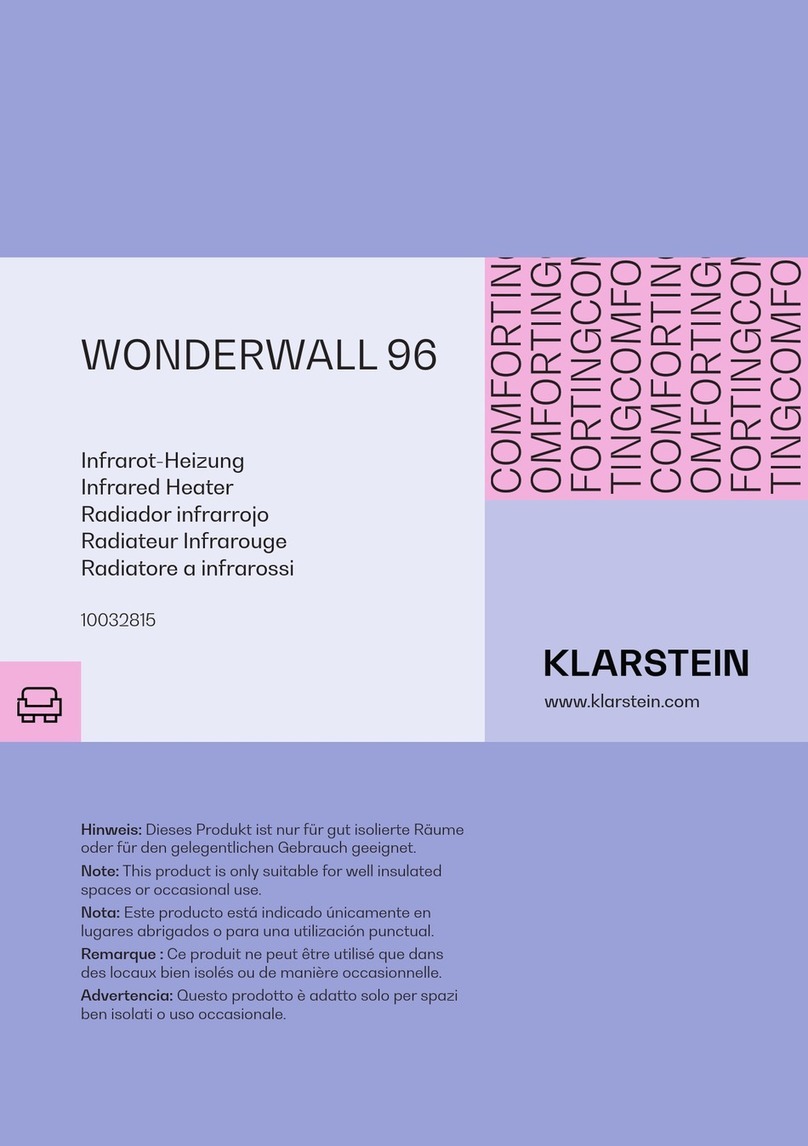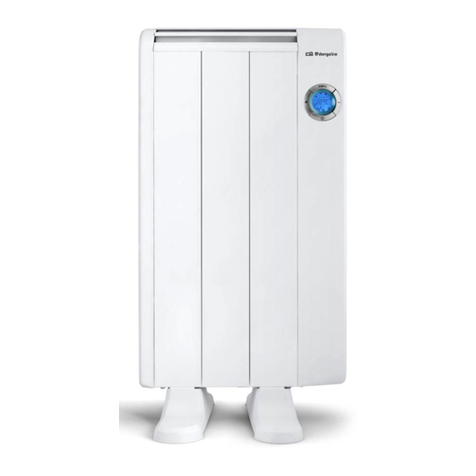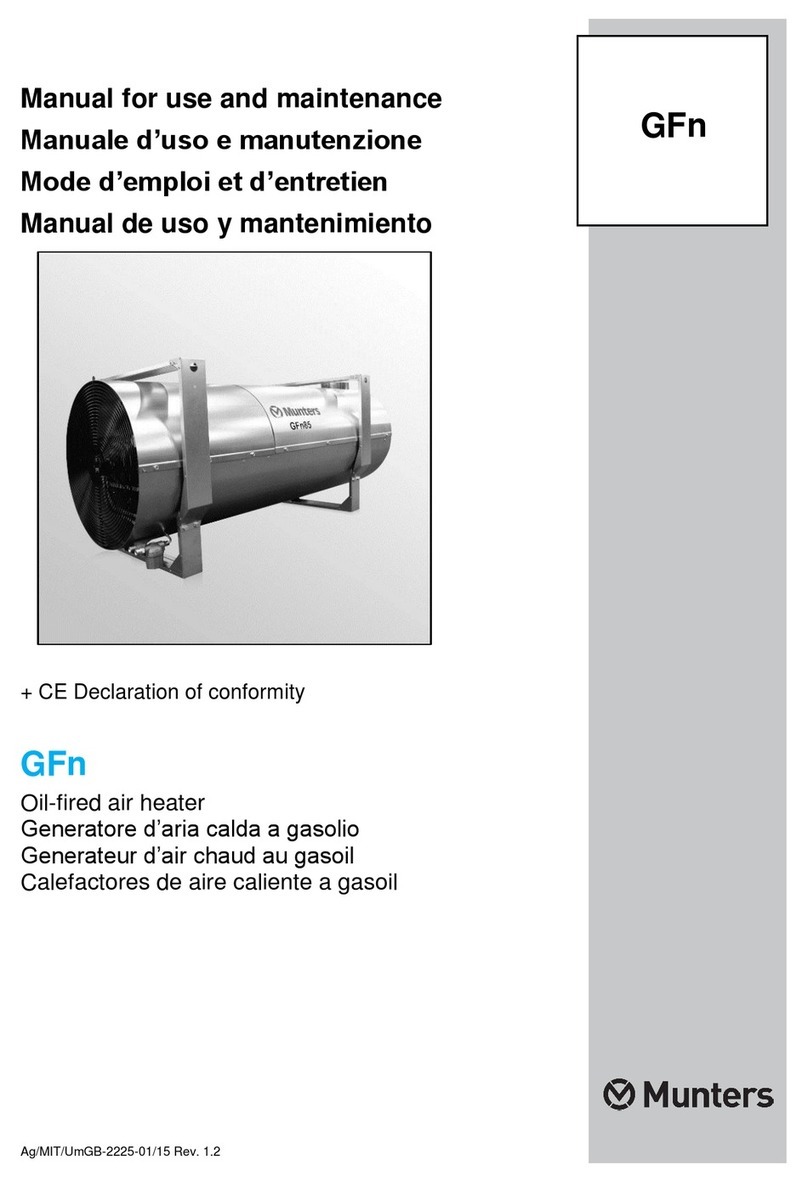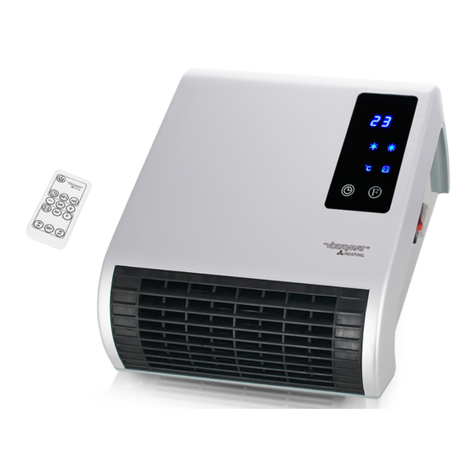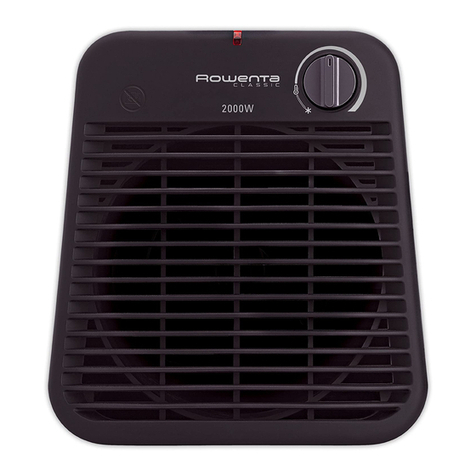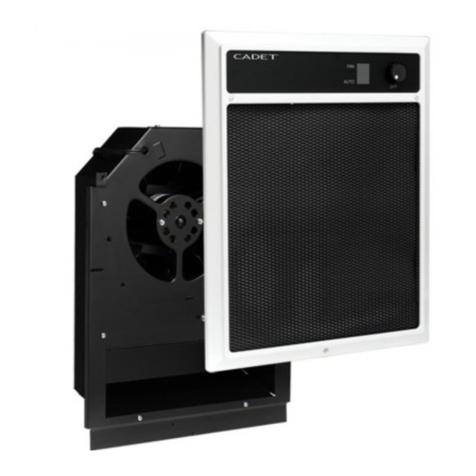GoGaS Goch KMI 20 - 1 Manual

LT152 November 4, 2013
Goch GmbH & Co. KG
Series KMI High Intensity Heater
Installation, Operation and Service Instructions
KMI 20 - 1
KMI 40 - 1
KMI 60 - 1
KMI 90 - 1
KMI 120 - 1
GoGaS Goch GmbH & CO. KG
Zum Ihnedieck 18
44265 Dortmund - Germany
Phone +49 231 46505-0
Fax +49 231 46505-88
Installer
Read and thoroughly understand these instructions before attempting any installation.
Owner
Retain this manual for reference.
Superior Radiant Products
www.superiorradiant.com
FOR YOUR SAFETY
If you smell gas:
1. Open windows
2. Don´t touch electrical switches
3. Extinguish any open flame
4. Immediately call your gas supplier
FOR YOUR SAFETY
Do not store or use gasoline or other
flammable vapors and liquids in the
vicinity of this or any other appliance.
CONSIGNES DE SECURITE
Si vous sentez une odeur de gaz:
1. Ouvrez les fenêtres
2. Ne touchez pas aux interrupteurs
électriques
3. Éteignez tout flamme nue
4. Contactez immédiatement votre
fournisseur de gaz
CONSIGNES DE SECURITE
Il est interdit d’utiliser des liquides
inflammables ou dégageant des
vapeurs inflammables, a proximités
de tout appareil fonctionnent au gaz.
WARNING
Improper installation, adjustment, alteration, service or maintenance can cause injury, death
or property damage. Read the installation, operation and service instructions thoroughly
before installing or servicing this equipment.

Serires KMI - 2 - November 4, 2013
CAUTION: FIRE OR EXPLOSION HAZARD
Maintain clearance to combustible constructions as further specified in this manual.
Failure to do so could result in a serious fire hazard. Heaters should not be located in
hazardous atmospheres containing flammable vapours or combustible dusts. Signs
should be provided in storage areas specifying maximum safe stacking height.
CAUTION: MECHANICAL HAZARD
This equipment is designed and approved for indoor use only. This product is not
intended to be installed indoors in residential applications.
CAUTION: FIRE OR EXPLOSION HAZARD
This heater equipped with an automatic ignition device. Do not attempt to light the
burner by hand. Failure to comply could result in a serious fire and personal injury
hazard.
CAUTION: MECHANICAL HAZARD
Do not use high pressure (above ½ psi) to the test gas supply system with the burners
connected. Failure to do so could results in damage to the burner and its control
components requiring replacement.
CAUTION: SERVICE LIFE RISK
Do not install equipment in atmospheres containing halogenated hydrocarbons or other
corrosive chemicals. High intensity heaters are not recommended for installation in
enclosed swimming pool areas. Failure to do so may lead to premature equipment
failure and will in-validate the warranty.

Serires KMI - 3 - November 4, 2013
Goch GmbH & Co. KG
TableofContents
PREFACE.......................................................................................................................................4
THETECHNOLOGY........................................................................................................................4
IMPORTANT.................................................................................................................................5
GENERALINFORMATION..............................................................................................................5
INSTALLATIONCODES.........................................................................................................................................5
GENERALINSTALLATIONANDGASCODES/ELECTRICALCODES...................................................................................5
AIRCRAFTHANGARINSTALLATION........................................................................................................................5
PUBLICGARAGES...............................................................................................................................................5
PARKINGSTRUCTURES........................................................................................................................................5
WARNING:........................................................................................................................................................5
LAYOUTCONSIDERATIONS...........................................................................................................6
SPOTHEATING..................................................................................................................................................6
SUGGESTEDHEATLOADINGFORINDOORSPOTHEATINGUNDERSTATEDCONDITIONS:...................................................7
FULLBUILDINGHEAT..........................................................................................................................................7
ENGINEERINGSPECIFICATIONS.....................................................................................................8
ENERGYSUPPLY.................................................................................................................................................8
MINIMUMCLEARANCESTOCOMBUSTIBLES...........................................................................................................9
INSTALLATIONSINSTRUCTIONS..................................................................................................10
HIGHINTENSITYMOUNTINGINSTRUCTIONS/CONFIGURATIONS.............................................................................10
HorizontallyMountedHighIntensityHeater...........................................................................................................10
Angledhighintensityheater....................................................................................................................................12
AIRPLATEINSTALLATIONINSTRUCTIONS..............................................................................................................13
Procedure:................................................................................................................................................................13
GASCONNECTIONS..........................................................................................................................................14
ELECTRICALCONNECTIONS................................................................................................................................15
Single‐stageelectricalconnection/WiringDiagram..............................................................................................16
VENTILATION...................................................................................................................................................17
CONDENSATION...............................................................................................................................................17
OPERATION................................................................................................................................18
SINGLE‐STAGEHIGHINTENSITYHEATER...............................................................................................................18
ControlOperatingSequence....................................................................................................................................18
Controlling/CheckingManifoldPressure...............................................................................................................18
ANNUALMAINTENANCE...................................................................................................................................19
TROUBLESHOOTING...................................................................................................................20
REPLACEMENTPARTSECTION....................................................................................................21
WARRANTY................................................................................................................................22

Serires KMI - 4 - November 4, 2013
Preface
GoGaS high intensity heaters represent an efficient and comfortable alternative to conventional
heating systems. The infrared gas fired heater is an atmospherically operated infrared heater
which converts most of the energy applied (natural gas or LPG) into thermal radiation. The
sensible radiation component within the vicinity of persons allows a reduction in the air
temperature, thus leading to energy savings.
The Technology
The GoGaS KMI Novus high intensity heater from the KMI series is a high-quality product with
ratings from 6 kW (21,000 BTU/h) to 36 kW (125,000 BTU/h). The modern injector burner allows
almost pollution-free operation, from the smallest to the largest heater unit, with only one
combustion chamber. The stainless steel combustion chamber is integrated in an insulated
hood. The hot waste gases collect under the hood and pre-heat the gas-air mixture in the
combustion chamber, leading to a maximum degree of radiation. The reflector is made of highly
reflecting material and directs the captured radiation towards the vicinity of persons.

Serires KMI - 5 - November 4, 2013
Goch GmbH & Co. KG
Important
This appliance must be installed in accordance with current connection and installation
regulations and may only be used in adequately ventilated rooms. The installation and operating
instructions must be inspected and understood before installation and before start-up.
Before installation it must be checked whether local gas distributions, gas types and gas
pressures as well as the settings of the appliance are compatible.
General information
GoGaS infrared heaters are manufactured in accordance with ANSI Z83.19-2009/CSA 2.35-
2009. Each appliance is subjected to a function test before it leaves the factory and is preset to
the relevant gas type. For setting up and operating radiation equipment, the following
regulations and guidelines must be complied with.
This heater maybe approved for either indoor or outdoor installation. Not for use in
residential dwellings, refer to Rating plate.
Installation Codes
The installation must conform with local building codes or, in the absence of local codes, with
the National Fuel Gas Code, ANSI Z223.1/NFPA 54, or the Natural Gas and Propane
Installation Code, CSA B149.1.
General Installation and Gas Codes/Electrical Codes
If an external electrical source is utilized, the heater, when installed, must be electrically
grounded in accordance with the National Electrical Code, ANSI/NFPA 70, or current Canadian
Electrical Code, CSA C22.1.
Aircraft Hangar Installation
Installation in aircraft hangars must conform to the Standard for Aircraft Hangars, NSI/NFPA 409
in the US and CAN/CGA B149.1 and B149.2 Installation Codes in Canada
Public Garages
Installation in public garages must conform to the Standard for Parking Structures, NFPA 88A or
the Standard for Repair Garages, NFPA 88B, in the US and CAN/CGA B149.1 and B149.2
Installation Codes in Canada.
Parking Structures
Technical requirements are outlined in ANSI/NFPA 88A (USA)
Warning: Heaters should be installed so that the minimum clearances marked on the heater will
be maintained from vehicles parked below the heater.
Important
These instructions, the layout drawing, local codes and ordinances, and applicable
standards such as apply to gas piping and electrical wiring comprise the basic information
needed to complete the installation, and must be thoroughly understood along with general
building codes before proceeding.
Only personnel who have been trained and understand all applicable codes should
undertake the installation. SRP Representatives are Factory Certified in the service and
application of this equipment and can be called on for helpful suggestions about installation.

Serires KMI - 6 - November 4, 2013
Layout Considerations
1. Because high intensity heaters are un-vented, ensure that adequate ventilation will be
available; most codes require a minimum of 4 cfm per 1000 BTUH of installed heat
capacity in natural gas, 4.5 cfm per 1000 BTUH for propane. Also see section on
Ventilation.
2. Check local codes for mounting requirements and the requirement for flexible gas
connectors or rigid mounting.
3. Do not locate heaters near windy locations such as door openings.
4. Do not locate heaters in very dusty environments
5. Avoid placing heaters below sprinkler heads or provide more than adequate clearance.
Spot Heating
High intensity heaters are ideal for spot heating applications. The following are key
considerations to the success of the application:
1. Minimize any wind in order to maximize the effect of the radiant heat.
2. Placing two smaller heaters opposing each other will be more comfortable than placing
one large heater.
3. Hang the heaters back and at an oblique angle (rather than directly overhead) in order to
maximize the exposure of the peoples’ bodies to radiant heat.
The following charts are intended for guidance only. Specific applications may require other
parameters.
Suggested Minimum Mounting Heights
Heater Input
Rate Mounting Angle
BTU/hr 0° – 10° 30°
ft m ft m
20,000 10 – 15 3 – 4.6 9 – 13 2.7 – 4
40,000 12 – 19 3.7 – 5.9 11 – 17 3.4 – 5.2
60,000 14 – 22 4.3 – 6.7 13 – 19 4 – 5.9
90,000 15 – 24 4.6 – 7.3 14 – 22 4.3 – 6.7
120,000 17 – 29 5.2 – 8.8 16 – 25 4.9 – 7.6

Serires KMI - 7 - November 4, 2013
Goch GmbH & Co. KG
Suggested heat loading for indoor spot heating under stated conditions:
Ambient Air
Temperature
BTU/hr per sq. ft of
Floor Area to be Heated
At 50 ft/min of wind
(15.2 m/min) At 100 ft/min of wind
(30.5 m/min)
40°F / 4°C 150—165 165—180
55°F / 13°C 75—88 85—100
Example:
Work counter for light assembly, space is 15 ft x 25 ft. (4.5 m x 7.6 m),
ambient air temperature 40°F / 4C, located near shipping doors.
Approximately 170 BTUH/sq.ft x (15x25) sq.ft = 63,750 BTUH
Two heaters at opposing locations would be preferred
Full Building Heat
Calculate the total heat input required, ensuring the inclusion of any unheated make-up air due
to exhaust fans. Use the following chart as guidance to heater placement.
Model/BTUH KMI-20 KMI-40 KMI-60 KMI-90 KMI-120
Heater
Mounting
Height,
ft (m)
Mounting
Angle 0°-10° 10-15
12-19
14-22
15-24
17-29
Mounting
Angle 30° 9-13
11-17
13-19
14-22
16-25
Distance of first heater
row
from outside wall, ft (m)
6
(1.9) 10
(3.1) 12
(3.7) 14
(4.3) 16
(4.9)
Distance between heaters
along outside wall*, ft (m) 8-20
(2.5 – 6.1) 15-30
(4.6 – 9.2) 20-40
(6.1 – 12.2) 30-50
(9.2 – 15.2) 40-60
(12.2 – 18.3)
Distance between rows –
out-side wall row to next
interior row, ft (m)
30-60
(9.2 – 18.3) 50-80
(15.2 – 24.4) 75-110
(22.9 – 33.5) 90-115
(27.5 – 35.0) 100-125
(30.5 – 38.1)
* Distance between heaters along interior rows should be up to twice the indicated number

Serires KMI - 8 - November 4, 2013
KMI20 43
KMI40 68
KMI60 94
KMI90 123
KMI120 170
23,00021,000
45,000
65,000
90,000
125,000
Weight
LBS
Nominal Thermal Load
Nat. Gas (Btu / h)
MODEL Nominal Thermal Load
Propane Gas(Btu / h)
44,000
66,000
90,000
125,000
A
5.90
13.80
19.57
ENGINEERING SPECIFICATIONS
Energy supply
Gas connection: ½” NPT female thread
Gas pressures
Connection Maximum Minimum
Natural Gas 14" W.C. 6.5” W.C.
Propane 14" W.C. 12” W.C.
Electrical connection
Alternating current AC, voltage; 24 V, 60 Hz with L, N and Ground (GND)
Power consumption: 12 W for single-stage infrared heaters
*5.25" W.C. for model KMI 90
MODEL "A"
KMI 20 18.90"
KMI 40 33.43"
KMI 60 47.95"
KMI 90 62.48"
KMI 120 91.54"
Single Stage
Gas
Pressure: Natural Gas Propane
Minimum 6.5" W.C. 12" W.C.
Maximum 14" W.C 14" W.C.
Manifold 5" * W.C. 11" W.C.

Serires KMI - 9 - November 4, 2013
Goch GmbH & Co. KG
Minimum Clearances to Combustibles
Combustible materials are considered to be wood, compressed paper, plant fibres, plastic,
Plexiglas or other materials capable of being ignited and burned. Such materials shall be
considered combustible even though flame-proofed, fire-retardant treated or plastered.
The stated clearance to combustibles represents a surface temperature of 90°F (50°C) above
room temperature. Building materials with low heat tolerance (such as plastics, vinyl siding,
canvas, tri-ply, etc…) may be subject to degradation at lower temperatures. It is the
installer’s responsibility to assure that adjacent materials are protected from
degradation.
ABCDEF
KMI20 15" 29" 90" 10" 22" 65"
KMI40 15" 29" 95" 10" 22" 65"
KMI60 15" 32" 100" 10" 22" 68"
KMI90 15" 35" 105" 10" 24" 70"
KMI120 15" 39" 110" 10" 24" 75"
Suspended
Horizontally Suspended at an
Angle up to 30°
MODEL
BB
12.20
22.83
Note: Venture
must always be
located in the upper
position
1/2" NPT
Inlet
14.02
Suspended at an Angle Up to 35°Suspended Horizontally
D
F
AE
C
C

Serires KMI - 10 - November 4, 2013
Installations Instructions
Figures below illustrate the typical mounting configurations for the Series KMI heaters;
verify which is permissible by local codes.
Heaters must be hung at an angle between 0° and 30°. Typically, at the walls they are at
30° facing into the building. The gas manifold must always be at the lower side of the
heater.
Minimum 3/16"diameter S hooks and No. 1/0 chain (200 lb./ 91 kg working load) is
recommended. Close S hooks after installation.
Never use a gas line as a hanging support and never locate gas or electric lines over the
heaters.
Maintain clearance to combustibles.
Ensure that there is a plugged tap upstream of the heater or a fitting on the valve itself to
verify incoming pipeline pressure.
Do not leave the heater connected when pressure testing the pipeline. The high pressure
will damage the equipment.
High Intensity Mounting Instructions / Configurations
GoGaS High Intensity Heaters are approved to be operated horizontally and a maximum of
30° inclined angles (as per figure below). Mounting kits are available and can be ordered
separately. Use mounting points located on the heater for installations.
Horizontally Mounted High Intensity Heater
Chain
Minimum Mounting Heights (horizontally) relative to Air Temperature
59° F 50° F 41° F
KMI20 179.53" 139.37" 124.80"
KMI40 226.38" 169.69" 148.82"
KMI60 262.20" 192.52" 166.93"
KMI90 292.13" 312.20" 182.68"
KMI120 342.91" 244.49" 208.66"
MODEL air temperature

Serires KMI - 11 - November 4, 2013
Goch GmbH & Co. KG
Mounting hardware
beam clamp suspension for pipe ring or
wooden main beam clevis

Serires KMI - 12 - November 4, 2013
Angled high intensity heater
Minimum Mounting Heights (angled at 30°) relative to Air Temperature
Type KMI 20 KMI 40 KMI 60 KMI 90 KMI 120
Hole spacing A(inches) 19.882 34.409 48.937 63.464 92.52
Weight (pounds) 31.00 48.50 66.10 86.00 119.00
Item Quantity Description Type
1 1 set Angled suspension AW 84/II
2 1 set Accessories AW 84/II
1
Right
2
1
Left
59° F 50° F 41° F
KMI20 162.60" 127.56" 115.35"
KMI40 201.97" 152.76" 135.43"
KMI60 232.28" 172.05" 150.79"
KMI90 257.87" 188.19" 163.78"
KMI120 300.79" 215.75" 185.83
air temperature
MODEL

Serires KMI - 13 - November 4, 2013
Goch GmbH & Co. KG
Air Plate Installation Instructions
Single Stage Infrared Heaters
Before the orifice housing is mounted to the Venturi neck, the Air Plate and orifice
sizes must be compared with the Rating plate specifications.
Procedure:
Remove the cable ties (not shown) from the Venturi Neck (some infrared heaters do
not have any air plates, and therefore no cable ties)
Push the orifice housing into the Venturi Neck and screw it tight using four M5 screws
provided.
M5 Screws
(QTY 4)
Air Plate
Venture
Neck
Orifice
Orifice
Housing
Single-Stage Version

Serires KMI - 14 - November 4, 2013
INCORRECT POSITIONS
WRONG
WRONG WRONG
WRONG
Heater Movement
Heater
Movement
Heater Movement
Heater
Movement
Air Flow Direction
Heater Movement
3" (7.62 cm) Max.
Displacement
12"
(30 cm)
CORRECT POSITIONS
Gas Valve
Incorrect Position
Gas Valve
Correct Positions WARNING
GAS PRESSURE
SWITCH MUST
REMAIN IN
HORIZONTAL
POSITION
Gas Connections
Connect the gas line (using an approved Flexible Gas Connector) to gas valve train
assembly, see figure below for the correct and incorrect connections.
Flexible connector should not be under tension when connected to the heater.
Refer to figure above.
It is recommended to test leak the system before connecting the heater to the gas
line as the leak test may damage the gas valve.
Provide a 1/8" NPT plugged tapping, accessible for test gage connection, immediately
upstream of the gas supply connection to the heater.
The Gas Valve should be installed in the upright position (vertically up @ 12 O’clock
position) or horizontally (3 or 9 O’clock positions) but not vertically down @ 6 O’clock
position) see figure below.
The Gas Pressure Switch must remain in the horizontal position at all times.
Carry out a leak test to the entire system by opening the gas valve, check for any
leaks and fix any leak issues.

Serires KMI - 15 - November 4, 2013
Goch GmbH & Co. KG
Single-Stage Version
Ground Wire (Green/Yellow)
Ignitor Cable (Black)
Flame Sensor Wire (Pink)
Connect to
Gas Supply
Electrical Connections
For your safety, shut off the main gas valve, and disconnect all electrical supply to
the High Intensity Unit.
Ensure the heaters are properly grounded.
Perform all work in accordance with local codes or the National Electric Code
ANSI/NFPA 70 or Canadian Electrical Code CSA C22.1.
Connect the Ignitor cable, Flame sensor wire and the ground wire as illustrated below.
This appliance is equipped with a safety control system designed to shut the burner off in
the event of inadequate gas pressures

Serires KMI - 16 - November 4, 2013
If mechanical exhaust or humidistat is used in the building, it is typical to interconnect
these in the heater circuit as shown in figure below.
Do NOT connect the Ignitor cable, flame sensor wire and ground wire together!
The Ignitor cable and Sense cable have different size connection that match the
appropriate connection on the ignitor. The ground wire is connected directly onto
one of the adjacent studs.
Push the insulating protector over the Ignitor cable and push it over the Ignitor electrode
after connection.
Single-stage electrical connection / Wiring Diagram
Connect the electrical lead wires to the gas valve control using these symbols (L1, N, and
GND) and make sure to ground the valve.
Make sure the input voltage going to the control assembly is a 24 V 60Hz AC before
connecting to the valve.
L1
N
HUMIDISTAT
L1
N
FAN #2
FAN
RELAY
FAN #1
When using a humidistat to
control exhaust fans, wire the
humidistat to cause the fan to
operate on humidity rise NOT
humidity fall.
Depending on fan horsepower, a
relay may or may not be needed.
Block Diagram for
interconnecting Fan / Humidistat
WIRING DIAGRAM ONE-STAGE
GREEN
S1
HV PINK
DSI RED
GREEN
BROWN
YELLOW
GND
V2
V1
TH
GAS VALVE
FLAME SENSOR
IGNITER BURNER
TRANSFORMER
T'Stat*
Optional Field Supplied / Wired
NEUTRAL
RED
24V
T'Stat*L1
GAS
PRESSURE
SWITCH
120V
GREEN
24V
BLUE
This Blue wire
is only used with CNE
control module

Serires KMI - 17 - November 4, 2013
Goch GmbH & Co. KG
Ventilation
Buildings using high intensity radiant heaters require ventilation. High Intensity type heaters are
considered un-vented gas fired appliances, requiring ventilation to supply combustion air and
dilute/remove the products of combustion.
Requirements for combustion air supply and dilution air vary by jurisdiction, building type and
specific installation details. See local codes for guidance. In general, where heaters are
installed without direct outside combustion air, fresh air ventilation must be provided to building
space (3 cfm per 1000 BTU/Hr in Canada, 4 cfm per 1000 BTU/Hr in the USA), Verify
applicable local codes in the USA as requirements change by jurisdiction.
Mechanical exhaust should be electrically interconnected with the heaters and should
always be installed in conjunction with inlet air openings. See “Block Diagram for
Interconnecting Fan/Humidistat” above for details.
Inlet air opening should be relatively small and distributed over the operating area of the
heaters. They must always be located below the level of the heaters. One square inch of
net free inlet area per 1000 BTUH is recommended.
Condensation
The products of combustion for natural gas contain up to 1 liter of water per 100,000 BTU
consumed. This may add substantial amounts of moisture to the building air environment and
may become a problem of condensation on cold surfaces within the building. This is particularly
true for poorly insulated metal roof decks or structural steel framing.
To decrease condensation, increase mechanical ventilation.
Ensure that continuous waterproof barriers are used on the inside of all insulated
surfaces.
Ensure that exhausters pull air from the entire space and across the condensing surface.
Humidistat controls may be integrated into the electrical control circuit of the heaters.

Serires KMI - 18 - November 4, 2013
Operation
Single-Stage High Intensity Heater
Ensure the gas supply line has been purged.
Open all gas cocks to the heaters and electrically energize the system.
Follow the instructions on the heaters Lighting Instructions Label. Check to ensure that
the thermostat starts and shuts down the system.
Do NOT operate the Infrared Heater if the gas pressure below 6.5” W.C. for natural
gas and 12" W.C. for propane.
Control Operating Sequence
Energise the system by 1). Connecting electricity to unit, 2) Set thermostat to call for
heat. Ignitor will spark after 30 seconds once the system energises, and the solenoid
valve will open permitting gas to flow. The flame sensor will try to sense flame by sending
current of 0.8A or greater to the flame sensor to confirm flame; if the flame sensor does
not sense flame in 15 seconds the solenoid valve de-energises and it will try to light two
more times, if it again fails to sense current it will go in lock out mode (fault mode 1 hour
automatic reset).
Reconnection after shut-down on fault
The device must be disconnected from the electrical supply for a period of at least 5 sec.
Then it must be connected or plugged in again as described above.
Re-ignition
If a malfunction occurs during operation, the ignitor will spark trying to ignite the gas for
the maximum duration of 15 sec. If no current is created within this period, the device
shuts down on fault.
Controlling / Checking Manifold Pressure
Connect the pressure gauge to the manifold pressure test nipple
Switch on the high intensity heater.
Compare the manifold pressure with the specifications on the rating plate and if
necessary correct manifold pressure.

Serires KMI - 19 - November 4, 2013
Goch GmbH & Co. KG
Annual Maintenance
Close the fuel gas valve and de-energize electrical power to the heater.
With an air hose regulated to no more than 15 psig blow away accumulated dust. Blow
across the face of the ceramic tiles, not directly at them. Blow into venturi for about one
minute.
Verify that there are no cracked tiles.
Review the wiring for any loose connections.

Serires KMI - 20 - November 4, 2013
Troubleshooting
Symptom
Possible Cause
Corrective Acton
Heaters will not turn off - Defective thermostat
- Stuck gas valve - Repair or replace
- Repair or replace
Gas Odor Loose pipe connection Verify all connections are
sealed by using an
appropriate leak test
Burning of gas/air
mixture inside Venturi
(flashback)
- Cracks between or
across ceramic grids
- Excessive drafts
- Replace burner head
assembly
- Shield or relocate heater
Heaters Cycles on/off
- Excessive drafts
- Flame sense not
grounded
- Low gas pressure
- Shield or relocate heater
- Verify wiring and correct
-
- Verify and correct
Low surface temperature
on ceramic surface
- Dirty or plugged
ceramics
- Low inlet gas pressure
- Misaligned
manifold/orifice
- Insufficient gas supply
- See cleaning / annual
maintenance section.
- Verify and correct
- Replace manifold
- Verify capacity of fuel
supply lines
No spark, no ignition
- No power to control
module
- Control module defective
- No power to spark
electrode
- No equipment ground
Verify and
correct/replace
Heater sparks but will
not light
- No gas supply
- Defective gas valve
solenoid
- Defective electronic
control
- Check shut off valve
and combination gas
valve
- Verify and
correct/replace
Heater lights but ‘locks
out’ after about 10
seconds
- Poor ground
- Reversed polarity on
electric supply
- Sense electrode not
sensing flame
- Defective electronic
control
Verify and
correct/replace
- Check continuity of
sense electrode
- Verify and/or replace
This manual suits for next models
9
Table of contents
Popular Heater manuals by other brands

Sure Flame
Sure Flame SE405 Service and maintenance manual

BN Thermic
BN Thermic CH Series instructions
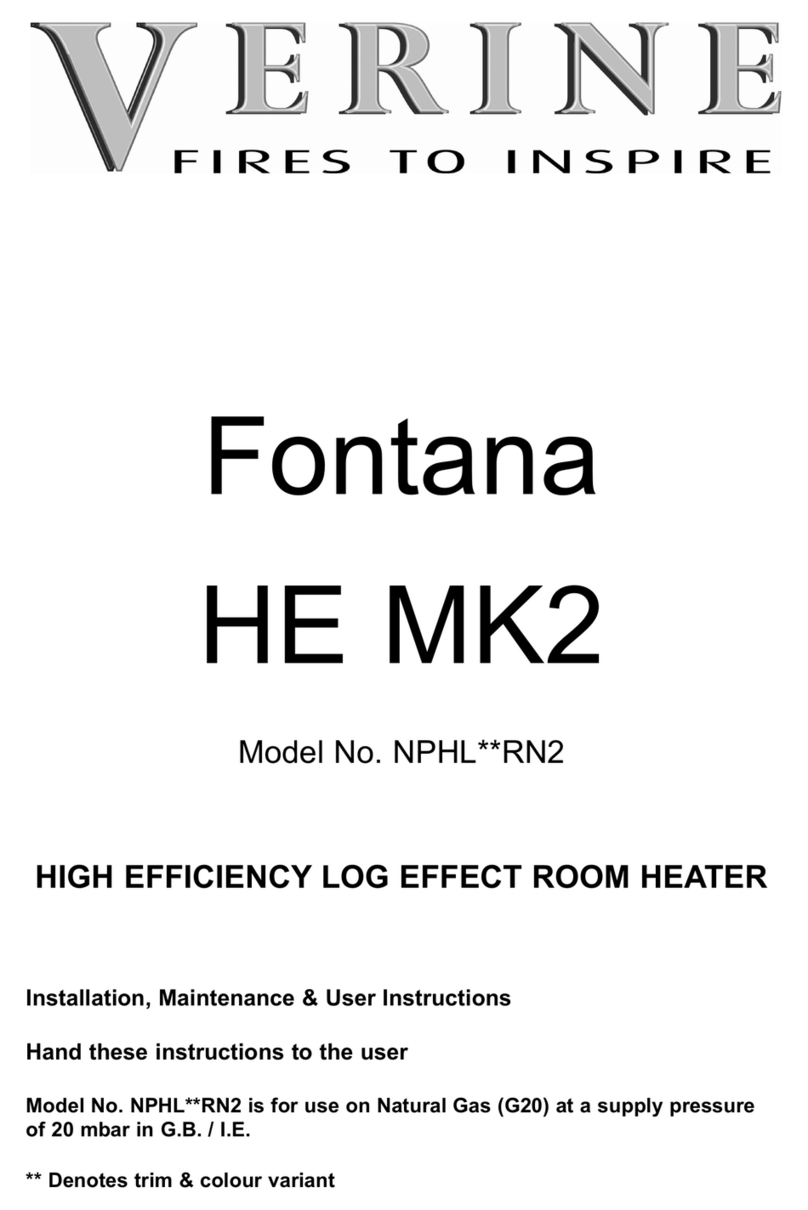
Verine
Verine Fontana HE MK2 NPHL**RN2 Installation, maintenance & user instructions

veito
veito BLADE Series instructions
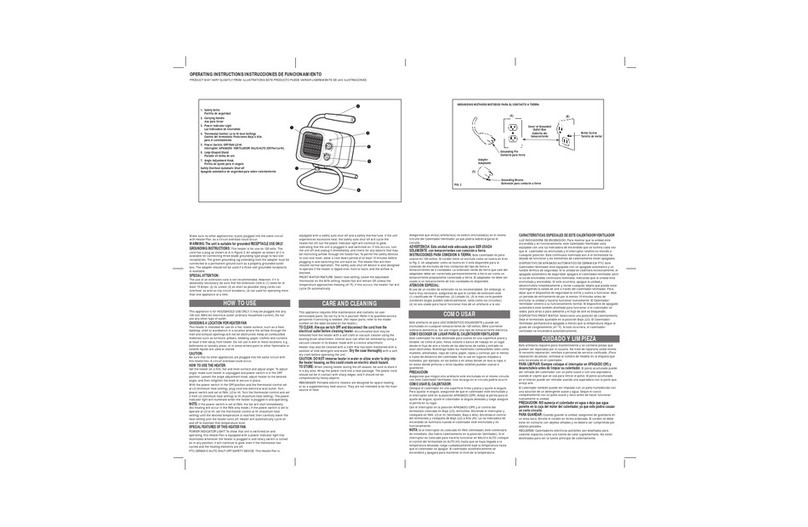
Windmere
Windmere YL-2500B-A Use and care book
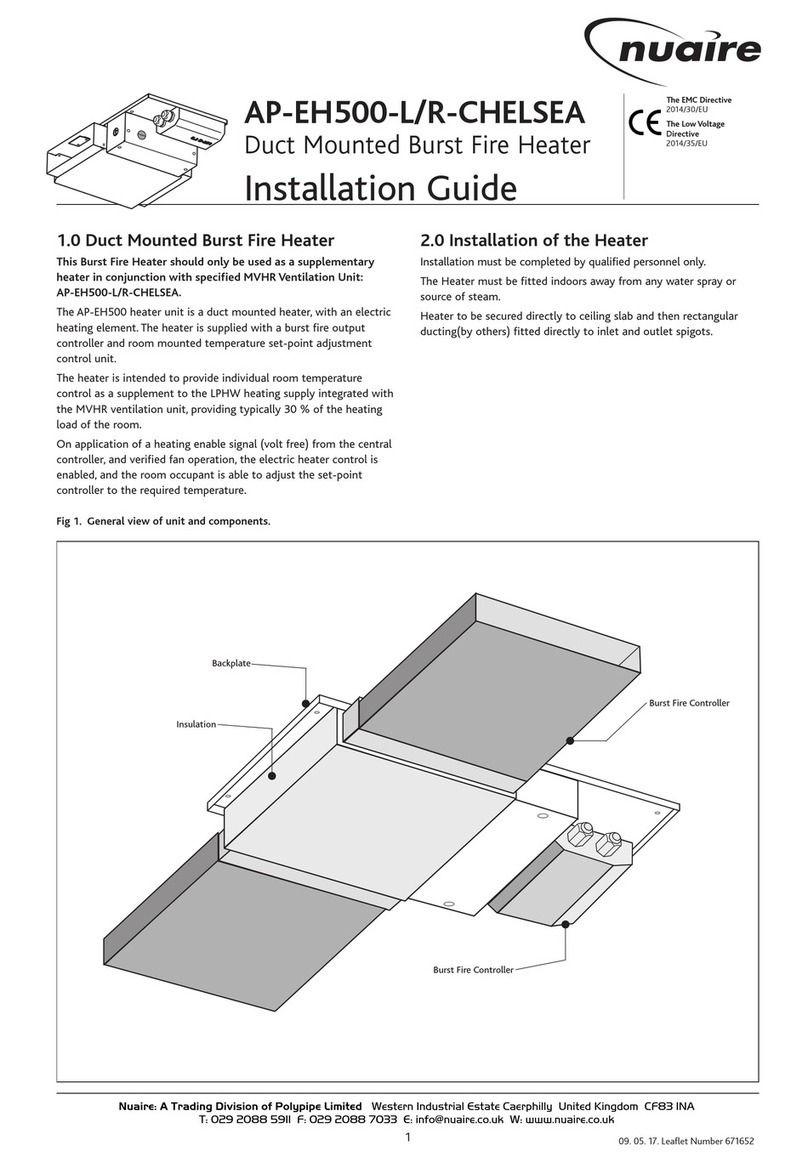
Nuaire Group
Nuaire Group AP-EH500-L/R-CHELSEA installation guide


